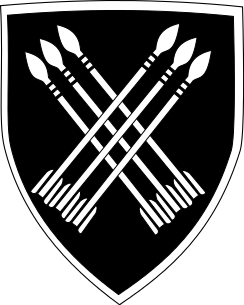32 Battalion
 | |
| Formation | 1976 |
| Founder | Jan Breytenbach |
| Type | military |
| An apartheid-era unit of the South African Army | |
Battalion 32, often referred to as the ‘Buffalo Battalion’, was created in 1976 by Col Jan Breytenbach. It was largely a black battalion and contained many foreign mercenaries. Its operational strength was approximately 1 500. Officers commanding 32 Bn were Col JD ‘Jannie’ Breytenbach (1976-7); Col GJ Nel (1977-8); Col Deon Ferreira (1978-83); Col EG Viljoen (1984-8); and Col MB Delport (88-93).[1]
Contents
History
After the victory of the Movimento Popular de Libertação de Angola (MPLA) in the Angolan War of Independence in 1975, many troops of its main rival, the Frente Nacional de Libertação de Angola (National Liberation Front of Angola, FNLA), found refuge in the then South African-controlled South West Africa.[2] From these troops, Colonel Jan Breytenbach together with Commandant Sybie van der Spuy formed a unit that was initially known as Bravo Group but later renamed 32 Battalion.
Redeployed as the SADF
Unlike other South African Defence Forces (SADF) units, 32 Battalion was mainly deployed in southern Angola, acting as a buffer between the SADF's regular forces and its socialist enemies. The unit was also used to assist the anti-communist movement of the National Union for the Total Independence of Angola (UNITA). Although it was mainly used as a counter-insurgency force it was eventually also used as a semi-conventional force, especially during the later phases of the war – particularly at the Battle of Cuito Cuanavale.
The battalion consisted of around 700 riflemen and NCOs (non-commissioned officers) (mostly Angolan nationals associated with the former FNLA or the Portuguese Army) and mainly South African officers, although commissioned military personnel from countries such as Australia, Rhodesia, Portugal and the United States were active with the battalion, especially in its early stages. As time progressed a number of SNCOs (senior non-commissioned officers – sergeants and above), distinguished themselves and were commissioned.[3]
At the end of its era in Namibia, the unit had developed into a conventional battle group. Apart from the infantry companies and the recce company, the battalion was strengthened by a battery of 120 mm (4.7 in) mortars, a squadron of Ratel ZT-3 and 90 mm (3.5 in) tank destroyers and a troop of 20 mm (0.79 in) anti-aircraft guns mounted on Buffel infantry vehicles. Although the main bulk of the battalion was based at Buffalo on the banks of the Okavango River, the HQ was in Rundu, 200 km (120 mi) to the west[citation needed].
Namibian independence
After Namibian independence in 1989-1990, the unit was withdrawn to South Africa where it was further used in a counter-insurgency role on South Africa's borders and later also in townships.
Phola Park Incident
On 8 April 1992 members of 32 Battalion were involved in an incident in Phola Park, Gauteng where members of the public were shot and killed.[4] The incident drew widespread criticism, specifically from the African National Congress (ANC)[5] and prompted the Minister of Defence to request an investigation by the Goldstone Commission.
Disbandment
As one of the results of the negotiations between the National Party and the ANC, the unit was disbanded in March 1993. After the battalion was disbanded, the remaining members of the unit were transferred to other SADF-units such as the Parachute and Mechanised Battalions as well as the Recces. It was also decided to reactivate 2-SAI at Pomfret which enabled about a quarter of the troops to return to Pomfret as members of the new 2-SAI. However, when 2-SAI was moved to Zeerust in 1999, many of them decided to rather stay behind at Pomfret and handed in their resignations. In 2008 there still remained about a quarter of the original 1,000 three-two families at Pomfret, eking out mainly a hand-to-mouth existence.
Many members of the unit later helped to found or joined private military companies such as Executive Outcomes and Sandline International, which fought on the side of the Angolan government against UNITA.
Equatorial Guinea coup
Some of the participants in the alleged 2004 Equatorial Guinea coup d'état attempt were former members of 32 Battalion.[6][7] Because they were arrested in Zimbabwe, it is not clear whether any of those arrested had full knowledge of their final destination or the alleged plan to carry out a coup d'état.[8]
People
Commanders
Personnel
References
- ↑ Truth and Reconciliation Commission of South Africa Report - Volume Two, Chapter Three, p324.
- ↑ https://web.archive.org/web/20080201115234/http://www.etext.org/Politics/AlternativeOrange/2/v2n2_misa.html
- ↑ International Defence and Aid Fund, January 1982
- ↑ http://hurisa.org.za/wp-content/uploads/2009/11/Goldstone-Booklet.pdf
- ↑ https://web.archive.org/web/20080708193835/http://www.anc.org.za/ancdocs/pr/1992/pr0410a.html
- ↑ http://www.iol.co.za/index.php?set_id=1&click_id=13&art_id=ct20040314091038442P430771
- ↑ https://www.washingtonpost.com/ac2/wp-dyn/A48639-2004Sep24?language=printer
- ↑ Once Upon a Coup, PBS Documentary, August 2009, https://www.pbs.org/wnet/wideangle/episodes/once-upon-a-coup/full-episode/?p=5496